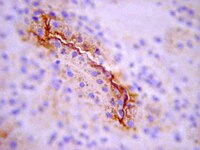Glucose transport by acinar cells in rat parotid glands.
Jurysta, C; Nicaise, C; Cetik, S; Louchami, K; Malaisse, WJ; Sener, A
Cellular physiology and biochemistry : international journal of experimental cellular physiology, biochemistry, and pharmacology
29
325-30
2011
Zobrazit abstrakt
Salivary glucose is often considered as being from glandular origin. Little information is available, however, on the possible role of glucose transporters in the secretion of the hexose by salivary glands. The major aim of the present study was to investigate the expression and localization of several distinct glucose transporters in acinar cells of rat parotid glands.Quantitative real-time PCR analysis, immunohistochemistry and western blotting techniques were used to assess the presence of SGLT1, GLUT1, GLUT2 and GLUT4 in acinar cells of rat parotid glands.Quantitative real-time PCR documented the expression of SGLT1 and GLUT1 in parotid tissues, with a much lower level of GLUT4 mRNA and no expression of GLUT2 mRNA. Western blot analysis revealed the presence of SGLT1, GLUT1 and GLUT4 proteins, but not GLUT2 proteins in the parotid extract. Immunohistochemistry confirmed these findings. SGLT1 was specifically located at the baso-lateral membrane, co-localizing with Na(+)/K(+) ATPase. GLUT1 was found both at the baso-lateral and apical level. GLUT4 appeared to be also located at the baso-lateral level. However, too little GLUT4 was present to allow co-localization labeling.Based on these findings, a model is proposed for the transport of glucose into the acinar cells and thereafter into the acinar lumen. | 22508040
 |
Glycosylation of the rabbit intestinal brush border Na+/glucose cotransporter.
Hirayama, B A and Wright, E M
Biochim. Biophys. Acta, 1103: 37-44 (1992)
1992
Zobrazit abstrakt
The glycosylation of the mature form of the rabbit intestinal Na+/glucose cotransporter was investigated by using both glycosidases and chemical treatment. The protein was identified on Western blots using polyclonal antibodies directed against peptide sequences from the cloned transporter as a Mr 68,000 polypeptide. The effect of these treatments on the size of the transporter is consistent with the major post-translational processing being a single N-linked glycosylation of either the tri- or tetra-antennary complex type. Either method of deglycosylation reduced the SDS-PAGE size by 11,000 to Mr 57,000. These results also suggest that O-linked glycosylation, if present, contributes little to the apparent size of the transporter. The relative size of the deglycosylated mature protein appears to be greater than that of the in vitro primary transcript (Mr 45,000), suggesting either a difference in a stable conformational state insensitive to reduction and denaturation by SDS or an additional post-translational modification. In addition, deglycosylation of the native transporter does not affect transport activity in brush border membrane vesicles. The transporter, an integral membrane protein having several membrane-spanning regions, has an anomalous mobility in SDS-PAGE as shown by Ferguson analysis. We estimate that the actual size of the mature Na+/glucose cotransporter is 86,000, and that N-linked glycosylation contributes about 15,000 to the mass. | 1730019
 |
Intestinal and renal Na+/glucose cotransporters share common structures.
Hirayama, B A, et al.
Am. J. Physiol., 261: C296-304 (1991)
1991
Zobrazit abstrakt
Polyclonal antibodies were raised to peptides selected from three different regions of the cloned rabbit intestinal Na+/glucose cotransporter. Western blot analysis was used to identify the fully mature protein in intestinal and renal brush borders. Two of the antibodies specifically identified a approximately 70-kDa protein band in rabbit intestinal brush borders but did not specifically immunoreact with membranes that do not have Na(+)-dependent glucose transport activity. The immunoreactive proteins had an apparent isoelectric point between pH 4.7 and 6.8. The antibodies also specifically recognized a similar-sized protein in human and seven other mammalian intestinal brush borders. Similar protein bands were identified in four mammalian renal brush-border membranes, indicating shared epitopes between intestinal and renal cotransport proteins. In some species, e.g., lamb and pig, the epitope for one antibody was missing in both intestinal and renal brush borders, suggesting that this epitope is not essential for function. These results suggest that 1) the cloned intestinal Na+/glucose cotransporter is that identified in earlier biochemical studies, 2) there is close structural similarity between intestinal and renal cotransporters, and 3) the structure of these proteins has been conserved during evolution. | 1714681
 |
















